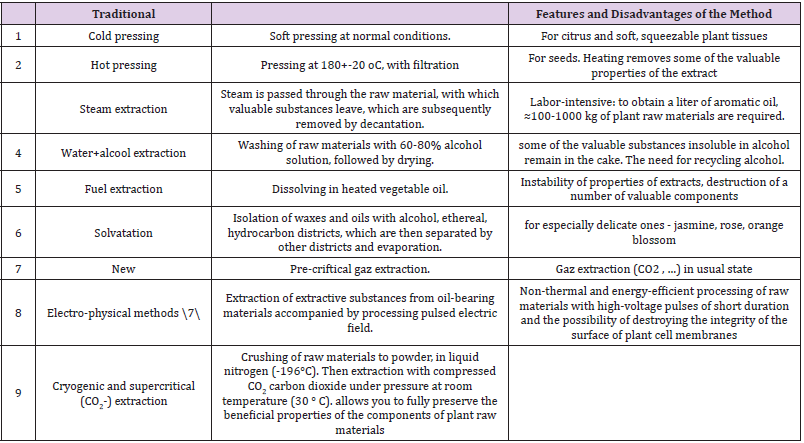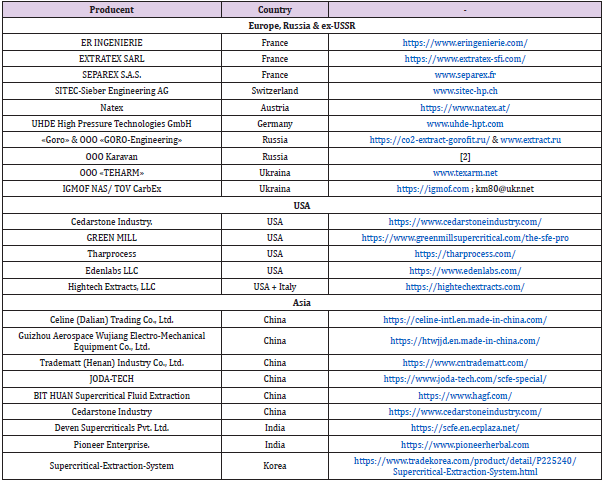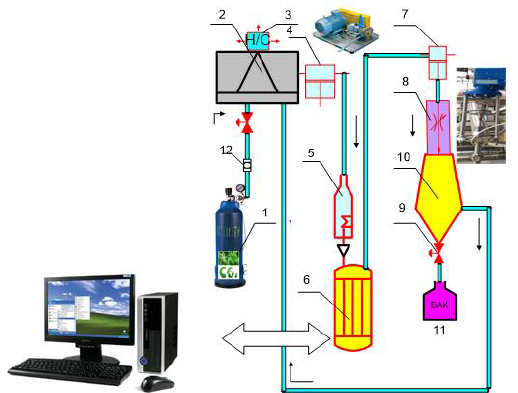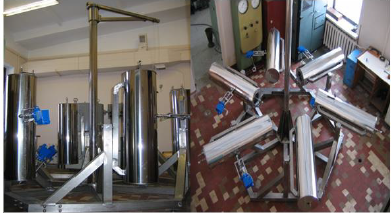Combined Mobile Unit for Supercritical CO2-Extraction of Bio-Active Components
Introduction
General information on methods for extracting active ingredients. The isolation and extraction of juices and oils have been known since pre-historic epoque. A large number of scientific and patent-commercial literature is devoted to extraction methods [1-21]. Simplistically, they are divided into traditional and new (advanced, innovative, etc, (Table 1) [1-8].
Let’s Take a Quick Look at the Same Existing Methods
Cold pressing can be considered one of the oldest and most proven methods. It was used in ancient civilizations. And since then, only the materials of the auxiliary parts have changed (plastic and chrome-plated instead of wooden). It is very effective for easily squeezed plant products.
Hot pressing remains an applied method in the food industry. Water-steam extraction is still considered the simplest and most effective method. According to Kasyanov [2], “distillation of volatile components with (100°C) allows to extract substances with low boiling point (150–250°C) from plant raw materials. The advantages of the steam distillation method include the availability of its implementation even in field conditions and the low cost of producing essential oils. But at a high temperature of distillation of volatile substances, denaturation and modification of a number of valuable components occurs. In addition, some essential oils require refining due to the presence of decomposition products.” The variant of method is a vacuum-distillation, which is more progressive than conventional atmospheric distillation, is used for refining crude oils [6,17].
Extraction with oils. It is relevant to this day, which is confirmed by the emergence of new patents on this topic [3]. The extraction method for extracting oils can be used in pure form (for soybean raw materials), but more often - in combination with prepressing (for high-oilseeds). Direct extraction of high-oil crops is difficult due to the high caking of such materials after grinding. When combining the extraction method with pre-pressing, at the first stage, up to 80–85% of the oil is extracted, which facilitates the second stage - extraction. The final products of the extraction are oil and fat-free material - meal [2-6].
Extraction with solvents depends on their polarity. As is known [2], according to polarity, solvents are subdivided into low polarity, medium and high polarity. And almost all vegetable oils dissolve well in non-polar solvents (hexane, gasoline, benzene, dichloroethane, etc.). Polar solvents (methanol, ethanol, isopropanol) are mixed with oils in limited quantities at room temperature; when heated, the solubility of oils in them increases [2]. In the practice of extraction of vegetable oils, the most widespread are aliphatic hydrocarbons -extraction gasolines etc. [2]. When using hydrophilic solvents (acetone, glycerin, ethanol), extracts are obtained that are soluble in water, but contain a significant amount of dyes and other undesirable substances. Hydrophobic solvents (hexane, dichloroethane, СCl4) extract fat-like substances better, but not carbohydrates, resins, gums [2]. When extracting with solvents, the method of drying. New effective methods - micro-wave or vacuum drying, allow maximum preservation of useful substances. These drying methods are used in the production of dietary supplements and fine synthesis products [2]. The disadvantages of solvent extraction are obvious and unavoidable: fire hazard, ecotoxicity (of most solvents), loss of quality of extracts when distilling off the solvent [1,2]. The main disadvantage is that solvent does not always ensure a sufficiently complete extraction of aromatic and flavoring substances from raw materials [2].
Pre-critical extraction. The disadvantages of solvent extraction are eliminated when extracting from plant raw materials with liquefied gases - butane, propane, liquid carbon dioxide, freons, etc. [1-5]. This explains the popularity of pre-critical gas extraction methods. A new method of extracting oils from oilseeds can be used in pure form (for soybean raw materials), but more often - in combination with prepressing (for high-oilseeds). Direct extraction of high-oil crops is difficult due to the high caking of such materials after grinding. When combining the extraction method with prepressing, at the first stage, 80–85% of the oil is extracted, which facilitates the second stage - extraction. The final products of the extraction are oil and fat-free material meal [1,2].
Processing by a pulsed electric field, have next advantages - nonthermal and energy-efficient processing of raw materials by short high-voltage pulses and the possibility of destruction the integrity of the surface of the membranes of plant cells [7]. But this method has not yet found widespread use in the processing of oilseeds, due to insufficient the studied mechanisms of mass transfer, energy calculations and electrical parameters of the processed medium.
Supercritical Extraction Method (SCE)
Super-critical extraction as a method has developed in the last 20 years, replacing traditional methods [1-8]. Supercritical technologies are a promising alternative to many existing technological processes, the functioning of which requires the creation of new equipment and corresponding tooling operating under high pressure [1,2]. In turn, supercritical extraction, with its intensive development, came to replace many traditional methods, displacing them [1-8]. SCFE is based on the property of a gas under the influence of pressure and temperature to pass into a fluid phase, which has the ability to permeate gas and the solubility of an inherent liquid. The development of supercritical fluid (SCF) technologies dates back to the early 80s of the last century and today is characterized by increasing interest. Analysis of literature data shows that over the past 20 years SCF-technologies have passed the stage from laboratory research to large-scale industrial production. At the same time, both technical problems and environmental problems of the modern world are being successfully solved [2].
Cryogenic crushing\supercritical extraction - has made it possible to obtain extracts, the main characteristics of which are purity, absence of solvents and preservation of the active principles of herbal plants. Which has become an unconditional qualitative superiority over traditional extraction processes [1]. The SCE takes place at the critical point (achieved with a special combination of temperature and pressure) when a homogeneous phase is formed with the properties of a liquid and a gas simultaneously [1-8]. Due to its low viscosity (gas-like), supercritical fluid is able to extract well any components with high efficiency. The method of extracting valuable components from raw materials with liquid CO2 in a subcritical state (critical point P = 7.4 MPa, t = 31.1°C), the main advantage is eco-purity, selectivity, absence of residual solvent, fireand explosion safety, chemical inertness (without catalyst), high diffusion, low viscosity and surface tension. And also - the general availability and low cost of carbon dioxide itself.
An important advantage is the possibility of one-stage production of the most valuable components that cannot be extracted by other methods - or are extracted costly and in multiple stages (for example, during hydrodistillation [8]). SCE let extract a valuable components, that are contained in small quantities (1- 3% of dry mass) which is very difficult separates from the natural matrix. Such raw materials primarily include spicy\aromatic, essential oil, waxes, aminacids, proteins and medical compounds [1-10]. This new method is in the stage of formation. Today, the advantages are so far compensated by the immobility of most production facilities. So, the equipment here is rather bulky and expensive - but you need a mobile one (for moving to the place of growing raw materials). There are problems in logistics - since in countries with a rich resource base there is no infrastructure, but there are long distances [1,2,8]. A lot of dissertations, patents and monographic works [4,8,13-15,21] are devoted to the solution of these problems. A good comparison of pre- and supercritical extraction methods is seen from Table 2.
It can be seen from it that it is the SCE method that makes it possible to extract the most difficult to access valuable components. Moreover, its efficiency increases with increasing pressure (Table 2). The properties of supercritical CO2 as a solvent can be controlled - with an increase in pressure and temperature, its dissolving capacity increases sharply [2-4]. For CO2, these parameters are - critical point P = 7.4 MPa and T = 31.1°C [2-4]. In the technical aspect, SCFE installations are significantly more expensive due to the technical complexity of the design and manufacture of the necessary elements and equipment assemblies. CO2 in a fluid state [1-10] has a number of advantages, such as: eco-purity, selectivity, absence of residual solvent; fire and explosion safety; chemical inertness (without catalyst); high diffusion, low viscosity and surface tension; general availability and low cost. An important advantage is the possibility of one-stage production of the most valuable components that cannot be extracted by other methods - or are extracted costly or in multi-stage [8-10]. Unfortunately, these advantages are compensated for by the lack of mobility of most of the plants produced, which requires new engineering solutions and investments [1-2].
The widespread use of mobile extraction plants is limited by technical problems and the corresponding high cost. CO2- extracts are obtained on universal extraction modules, which are hermetically sealed metal cylinders interconnected by technological pipelines equipped with shut-off and control valves and pressure gauges. New technical solutions and additional capabilities formed the basis of the extraction equipment manufactured by world market leaders (Table 3). Noteworthy is the concentration of SCFE manufacturing companies in Europe, North America, Asia and the Middle East. The Asian market is developing dynamically thanks to the manufacturing companies of China, South Korea and India. using a modular approach thanks, among other things, to a huge resource base. The main focus in India is on the use of SCFE in the production of food ingredients. China has a priority in phytopharmaceuticals. The main manufacturers of CO2 equipment in Russia are cited in south regions (Krasnodar, Rostov) [7,9,13].
The geography of location of manufacturing companies covers all continents, which are concentrated mainly in industrialized countries. It should be noted that there is a tendency for the commissioning of SCFE plants for plant raw materials with a processing capacity of 2000t / year in the Polish segment [8,16] of this high-tech market. Modern SCF extractors have a constant trend of improvement and modernization. Laboratoric extractors is also in great demand, (as example HPEP, NOVA-Swiss, Effretikon, Switzerland), but its use is limited only to research use. With regard to mobile solutions for SCFE plants, two “good mentions” are known. The successfully implemented project of a pilot mobile supercritical extraction plant SuperEx - by group from New Zealand [19] installed a pilot extraction system in a standard sea container. Which opens up prospects for expanding the SCFE equipment line for operation in non-stationary conditions, including directly in the zones of raw material growth. The another example is authomobile\ biodiesel extractor from Sh.Yamada [20].
Our Combined Model of Scf-Extractor
Our group has experience in the creation and service of machines,devices and equipment for various fields (Industrial/ geological [22],field equipment [23],prosthetics [24-,25]. Our CO2 extraction unit includes the following interacting systems: a) Mechanical, which provides the process of CO2-fluid circulation, control and monitoring mechanisms in the system, b) Thermal, which ensures the transition of CO2 from the gaseous to the liquid phase and vice versa, c) Electronic, which provides settings for control and monitoring of technological parameters of the extraction process, d) Electrical, ensuring the operability of the compressor, refrigeration equipment and heating elements. Thus, an urgent task is the development of mobile equipment for deep processing. Which implies the creation and application of technologies that allow the wasteless use of all components of valuable raw materials to obtain environmentally friendly products with high added value.
Main Technical Characteristics of “CarbEx 40-i \ 500”
a) Extractor: 0.5 l, 1 l, 2 l, 5 l / 50 MPa, 10 l, 24 l / 40 MPa, 40 l / 320 MPa, for the extraction of both solid and liquid materials. He is equipped with a jacket for circulation heating with temperature control.
b) Separator: 0.3-24 l / 30 MPa, 40 l / 16-22 MPa, equipped with a jacket for circulation heating with temperature control.
c) High pressure pump: 20 / 40L MPa (double plunger); 50l / 50 MPa (two-plunger with frequency regulation); 400l / 40 MPa, three-plunger with frequency regulation.
d) Cooling system: equipped with a compressor.
e) Heat exchange and temperature control system: In accordance with the technological requirements, it is supplied with an extractor and a separator. Provides temperature control up to 80 0C. A digital display is used to monitor the fluid. Temperature control accuracy ± 0.1 0C.
f) Pressure control (safety system): Equipped with an electrical contact pressure sensor at the outlet of the high pressure pump. Also, he equipped with a pressure relief valves of the high pressure pump (extractor, separator), in accordance with their maximum working pressure to automatically release pressure in case of excess. The extractor is equipped with a system of back pressure valves at the outlet, which control a stable pressure and ensure its accurate adjustment. The accuracy of pressure control in the flow is ±0.1 MPa.
g) Flow indicator: Metal rotary flow meter with remote digital display to monitor instantaneous flow and operating time.
h) Piping: All tanks, taps, fittings and pipelines in contact with the CO2-fluid are made of stainless steel.
The universal equipment is designed for the extraction of complete and fractional fluid supercritical CO2 extracts from solid and liquid matrices of biological origin (roots, flowers, seeds, leaves, etc.). Scopes of equipment are: pharmaceuticals, food industry, cosmetics and chemical industries.
A number of original technical solutions have been introduced into the experimental mobile installation, which provide fast molecular purification of the extraction system when switching to another type of raw material within a short preparatory period:
Flexible technological solutions have been applied: 1 extractor - 4 accumulators, 2 extractors - 3 accumulators, 3 extractors - 2 accumulators, 4 extractors - 1 accumulator (readjustment for the processing of raw materials 10-40 dm3);
Adjustable position of extractors and storage extractors: vertical (for solid matrices), horizontal (for liquid matrices);
The original lifting mechanism with a swivel boom for the “reductor gear-shutter-glass” system;
The original design of the reducer of the upper gate of the highpressure reactor for accelerated unloading and loading of raw materials;
Automated control and monitoring system;
Modularity of installation. Possibility of connecting additional high-pressure reactors, co-solvent blocks, rectification columns;
Possibility of uninterrupted (round-the-clock) work in the cycle “work - stop - work”. Modernization of equipment by processing raw materials in special containers. Retrofitting of equipment for obtaining various extracts during the transition from one raw material to another.
The original tangential introduction of the extraction flow into the cyclone-cup of the accumulator, provides a solution to various technological processes: micronization, microencapsulation, microgranulation, impregnation, sterilization, molecular purification of products for various purposes, etc.;
Original attachment mechanism “cup - shutter” to optimize operations for loading and unloading raw materials and unloading the product;
A number of new original technical solutions have been introduced into the design of the mobile supercritical fluid CO2 extraction unit - in particular, the design of the throttle valve, mounted in an assembly with a storage device. With the help of a mechanism that opens the shut-off needle of the valve, the fluid extract of the raw material is supplied from the extractor with a pressure variation P≥40 MPa (400 atm.) in the accumulator up to 10MPa. As a result of the extraction, the temperature, pressure and flow CO2-rate in the extractor and storage tank are monitored on the basis of preliminary experiments. Thus, the optimal dimensions of the flow cross-sections of the valve and high-pressure pipelines are selected, for the predicted technological cycle of the extraction process of the feedstock. The valve design is a rather complex system for moving the shut-off needle from the high-pressure chamber (extractor) to the low-pressure chamber (accumulator).
The design also includes a safety mechanism that has the ability to block the failure of the stem and shut-off needle in case of exceeding the working pressure (when the operating characteristics in the system are exceeded). In the event of a change in the volume of the extractor and storage device during the technological processes of processing the feedstock, the design of the valve changes in dimensions and flow sections, based on the barometric indicators of the processing process. The design of the valve allows the use of shut-off needles with various shapes: conical, parabolic, etc. The proposed technical solutions will be reflected in detail in the corresponding patent documents. Economically, SCFE technologies are justified in the case of processing high-value raw materials with a high content of biologically active substances (biologically active substances), especially plants, which are the halo of growth, which is a given territory. In our scientific arsenal there are developments in processing technologies: seeds of flax, thyme, amaranth, millet, rose hips, and a method for obtaining extracts from plant raw materials has been worked out [21].
The extraction process is determined by the following main indicators:
extraction time, temperature and pressure in the extractor, temperature and pressure in two separators, gas phase flow rate. Development of optimal technological modes of fluid extraction of raw materials is carried out according to such indicators: pressure, temperature, cycle time, rational product yield, flow rate, modulation of CO2 flow and pressure, optimal humidity, etc.
Main Technical Characteristics
a) Maximum working pressure - 500 kg / cm2;
b) Maximum operating temperature – 800С;
c) The maximum number of fractions - 4;
d) Extractor volume - 10 dm3;
e) Storage volume - 10 dm3;
f) Volume of the storage extractor - 10 dm3;
g) The volume of the filter-drier - 10 dm3;
h) The volume of the extraction cup - 8 dm3;
i) The volume of the storage cup - 7 dm3;
j) The volume of the filter drier cup - 8 dm3;
k) Installed electric power - 10 kVA
Distinctive features and advantages of the equipment developed at TOV KarbEx in the Institute of Geochemistry and Mineralogy of the National Academy of Sciences of Ukraine, over similar similar equipment of foreign production are:
1) Possibility of readjustment of equipment for another type of raw material, depending on market requirements, within a short time (1-2 hours), additional installation of a parallel circulation arm, which ensures uninterrupted operation of the system.
2) Original design of an automated CarbEx control system, which allows smoothly regulating the CO2 consumption, which contributes to a change in the density of the fluid. It let to obtain extracts of various composition and quality, as well as, depending on the type of raw material, and accordingly program the extraction control process. 3) The SCFE process with CO2 solvent requires small production areas (25 to 50m2).
4) Low power consumption of equipment - from 2 to 15 kW. Thus, the developed SCF-extraction unit fully complies with the main criteria of environmental friendliness, efficiency, safety for processing plant raw materials in accordance with the standards for natural food ingredients in its mobile version. The presented installation expands this class of equipment and allows you to extract numerous types of plant raw materials and to compete with known analogues. In our arsenal there are the possibilities for the production of SCF equipment and optimization of the technological cycle for extracting various types of modes of SCF technology for the qualitative and quantitative composition of extracts.
Samples of Extracts
With the help of the declared equipment, we have obtained a number of fatty and aqueous solutions of bio-extracts. (Figures 1-3) shows that their chromatograms have 2-6 characteristic peaks corresponding to the yield of the basic components of the extract. The most successful versions of ekstraction products are designed in the form of commercial series (Figure 4).
Figure 1: Schematic diagram of a laboratory fluid CO2-extractor:
1. CO2 ballon-cylinder; 2. Refrigeration equipment; 3. Heat exchanger; 4. High-density compressor; 5. Heater; 6. Extractor; 7. Throttling valve; 8. Flow-changer in throttling valve when the high-density is dropped; 9. Shut-off valves; 10. Separator; 11. Container for receiving the extract; 12. Filter.
Conclusion
a) Manufacturers of equipment for SCF CO2 extraction are highly technically developed countries with huge industrial potential and engineering infrastructure, which have their own companies with a closed production cycle.
b) The proposed model of the CO2 extraction plant has a number of advantages over the known analogs and creates competitive opportunities for prospective use as an alternative mobile equipment in world markets.
For more Articles on: https://biomedres01.blogspot.com/









No comments:
Post a Comment
Note: Only a member of this blog may post a comment.